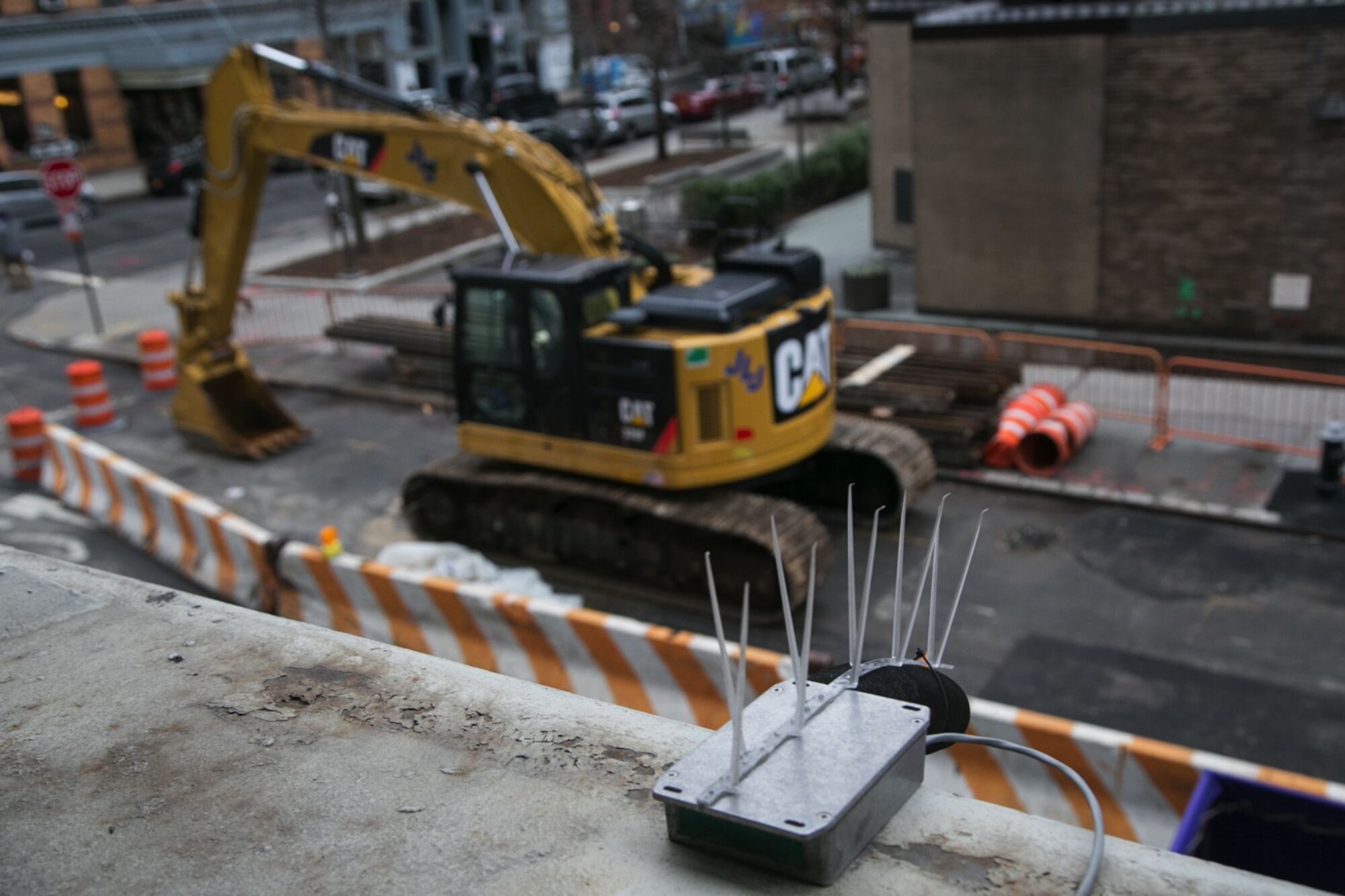To reduce noise, cities need new sensor technology that can tell the difference between a dog barking, a garbage truck and a revving motorcycle engine.

A sensor deployed by researchers measures noise levels and collects data to train an AI model to automatically recognize the origin of the sound.
Courtesy of SONYC/Charlie Mydlarz
By Linda Poon
December 2, 2021,
Linda Poon is a writer for CityLab in Washington, D.C., focused on climate change and urban life. She also writes the CityLab Daily newsletter.@linpoonsays
Any city dweller is no stranger to the frequent revving of motorbikes and car engines, made all the more intolerable after the months of silence during pandemic lockdowns. Some cities have decided to take action.
Paris police set up an anti-noise patrol in 2020 to ticket motorists whose vehicles exceed a certain decibel level, and soon, the city will start piloting the use of noise sensors in two neighborhoods. Called Medusa, each device uses four microphones to detect and measure noise levels, and two cameras to help authorities track down the culprit. No decibel threshold or fines will be set during the three-month trial period, according to French newspaper Liberation, but it’ll test the potentials and limits of automating the war on sound pollution.
Cities like Toronto and Philadelphia are also considering deploying similar tools. By now, research has been mounting about the health effects of continuous noise exposure, including links to high blood pressure and heart disease, and to poor mental health. And for years, many cities have been tackling noise through ordinances and urban design, including various bans on leaf blowers, on construction at certain hours and on cars. Some have even hired “night mayors” to, among other things, address complaints about after-hours noise.
But enforcement, even with the help of simple camera-and-noise radars, has been a challenge. Since 2018, the Canadian city of Edmonton has been piloting the use of four radars attached to light poles at busy intersections in the downtown area. A 2021 report on the second phase of the project completed in 2020, found that officials had to manually sift through the data to take out noise made by, say, sirens. And the recordings didn’t always provide strong enough evidence against the offender in court. It was also costly: The pilot cost taxpayers $192,000, while fines generated a little more than half that amount, according to CTV News Edmonton.
Those obstacles have made noise pollution an increasingly popular target for smart city innovation, with companies and researchers looking to make environmental monitoring systems do more than just measure decibel levels.

A sensor deployed by researchers behind SONYC.
Courtesy of SONYC/Charlie Mydlarz
In one of the noisiest cities in the U.S., a group of researchers at New York University have been studying New York’s sound environment since 2016 in hopes of developing a network of smarter sensors. That is, sensors that use machine learning to help city officials not only better address 311 complaints about noise, but proactively set targeted policies to minimize the activity from which they originate.
“As the current tool to understand noise, 311 is totally flawed because it's a very reactive way of dealing with noise,” says Charlie Mydlarz, a senior audio researcher who’s part of the SONYC (Sounds of NYC) project funded by the National Science Foundation. “There has to be a noise problem for someone to pick up the phone to actually log a noise complaint.” The process is not only slow and limited by staffing resources of the city, he adds, but it’s also not representative of the city’s population, with complaints largely coming from wealthier neighborhoods.
A network of nearly 100 sensors has gathered “hundreds of millions of rows” of anonymized data from around the city — including audio snippets and data on decibel levels that will help the team understand noise patterns, how loud the city is in certain areas and how they vary over time, Mydlarz says. More than 2,800 citizen volunteers recently helped identify and label a subset of the audio snippets, which is used to train a machine learning model to automatically distinguish the nature of the various noises. Mydlarz adds that the samples have been randomized and broken up to preserve privacy, and that it’s unlikely for the sensors to pick up intelligible conversations from where they were placed — usually high off the ground.
Now in its second phase, the team is working with the city’s Department of Environmental Protection to trial a network of roughly 30 low-cost sensors deployed in residential neighborhoods and mounted to the homes of residents who’ve complained to the DEP about chronic noise issues. The sensors can stream real-time data on decibel levels in the neighborhood and source identification of noise disturbance to the department, which will help them better distribute and lead to a more immediate response time.
They can give the city concrete data to propose changes in regulation to, say, construction permits, if they detect a pattern among the noise violations. Mydlarz says their project has already proved useful in the Red Hook community of Brooklyn, where the waterfront has seen an influx of warehouses thanks to the e-commerce boom. Residents say trucks often pass through residential neighborhoods, clogging up streets and generating excessive amounts of noise.
“Our sensors were being used to generate data that then is used to convince the city agencies to reroute trucking away from residential areas,” says Mydlarz. The data illustrated just how loud the trucks are, and on Oct. 29 last year, the community board unanimously supported a resolution asking the city department of transportation to consider such changes.
As for residents, the noise monitoring network comes with an app that also provides context about the noise they’re hearing — if there is a permit for a construction project nearby, for example. The researchers are currently looking for more volunteers so they can deploy more sensors. (Mydlarz says they would ideally like to mount sensors on light poles and other city infrastructure, but are limited by which city agencies they’re able to partner with.)
The hope is to generate more support from both city officials and residents. “What we want to do is to show them the loop,” he adds, “meaning you deploy a sensor, you see the data, the DEP enforces [the noise code], and measure the impact of that enforcement.”
Paris is already deploying a similar strategy. Medusa, the type of sensors that the city will be using, was developed by the local environmental noise monitoring nonprofit Bruitparif. First tested in 2019 near busy bars and construction sites in the suburbs outside Paris, the sensors measure decibel levels several times per second. Images captured on camera combined with the nonprofit’s own technology displays the sound snippets as colored dots representing different noise levels, essentially allowing officials to “see” noise traveling from its source.
Like SONYC, Medusa aims to add crucial information to noise disturbance in hopes of answering a question that’s far more complex than it initially seems: “Where does the dominant noise come from?”











